Let’s play a short game.
Look at the picture below. Then set a timer and see how long it takes you to find the numbers 1-100 in order. (Do this now without reading any further, otherwise you’ll ruin the game.)

Now perform the task a second time. However, this time use the picture below which has been divided into quadrants. Number 1 will be in the upper left corner, 2 will be in the upper right corner, 3 in the bottom right, and 4 in the bottom left. The numbers will continue in order, following that clockwise pattern. See if this simple bit of information about the organization affects your time.

Did your time get faster? I’m willing to bet it did. That’s because you knew how the numbers were organized the second time. This exercise comes from Dr. Elizabeth Patrick-Trippel’s dissertation titled, “Experiential Learning in Communication Courses: Development and Evaluation.” This simple activity helps to illustrate how we are able to process information more easily if it falls into a clearly organized pattern.
Organization is an important concept for those of us who are in the business of developing or delivering presentations. So today, we’ll look at one simple organizational strategy you can employ: the use of ordinals.
Ordinals are numbers that show sequence. When you say “first,” “second,” or “third” during your presentation, it’s similar to the addition of the gridlines on the second picture above. Ordinals allow you to separate a lot of information into more manageable bits. Let’s look at how that one small strategy can make a big difference.
Ordinals Provide a Map
During the beginning of your presentation, it’s a good idea to let the audience know where you are heading. Using words like “first” and “second” helps them to understand what they can expect and when. Even just this little bit of guidance can be comforting to the audience because it gives them a sense of participation and control.
Ordinals Grab Attention
Ordinals also draw attention to themselves. They work like verbal highlighters, telling us to pay attention to what follows them. Think about it. We’ve learned that important things follow ordinals. Even when we were little, “first” and “second” were usually tied to instructions that needed our attention. So it’s no wonder that we listen closely when these words are mentioned.
Ordinals Signal Movement
One of the easiest places to lose an audience member is during a transition from one thing to another. In his article, The Art of Keynoting, Alf Rehn says, “A transition is a signal to the audience that you’ve moved from one part of your talk to another, [transitions] establish that the audience can take a breath, let go of their previous focus, and establish a new one. Such transitions needn’t be long, as they exist primarily as a kind of mental pause.” Ordinals help audience members let go and move on by signaling that something is about to change.
Ordinals Help the Audience Process
Ordinals help audience members remember that a presentation is a larger unit made up of smaller parts. That makes the presentation less intimidating. “Chunking” is a term we’ve talked about before. It’s the scientifically-proven concept that says we can remember things better if they are divided up into smaller, more digestible bits. You use chunking every time you learn or recite a phone number or social security number. When you divide the content in your presentation into smaller parts, and then help the audience move through those parts with the use of ordinals, the information will be easier for them to process.
Try using ordinals in your next speech. It’s pretty amazing what these tiny little words can do both for your presentation and for your audience.
Ethos3 is here to help you master the art of presenting. Check out our full line of presentation design and training services now.